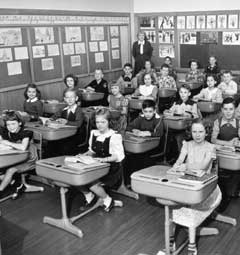In 1896, the supreme court chiefed by Melville Fuller ruled against Homer Plessy’s claim the segregated rail cars violated the equal protections clause of the fourteenth amendment. In this landmark case, the separate but equal doctrine was established and legally unchallenged for over half a century. Such a proceeding concluded the reconstruction era and represented the dawn of the Jim Crow era of American history.
The term “Jim Crow” originated from a minstrel character portrayed by Thomas Dartmouth Rice in the early nineteenth century. Within the performance, Jim Crow was a foolish and illiterate black man. Unfortunately, this figure became a derogatory stereotype for African Americans and exemplified the racist ideals of segregation.
Soon after the Plessy v. Ferguson's case upheld the Louisiana state law enabling segregation on state railroads, racial separation spread rampantly across the south into other forms of accommodations. In horror, black Americans in the south watched as schools, businesses, sports, and other sectors of public life implemented segregational practices. Although greater racial progress had been made in the north, similar policies were implemented and followed; housing discrimination are impartial lending policies, examples of attempts in the North to exclude black people from white communities.
Expectedly, African American citizens were abhorred by these policies that aimed to limit their freedoms. While there were protests and movements to reverse these discriminatory policies, the violent tactics of white supremacist groups, such as the Ku Klux Klan and the Red Shirts, annihilated any momentum. Furthermore, policies were implemented to disenfranchise African Americans and prevent opposition to Jim Crow Laws. These measures included impartial voting requirements such as grandfather clauses and poll taxes.
It was not until the middle of the twentieth century that black Americans began to recover their freedoms. One of the most pivotal supreme court rulings of this era was the Brown v. Board of Education which took place in 1954. While there were ardent arguments made for both sides using ethical, economic, historic, and cultural rationale, the all powerful Judge Smith ruled in the favor of Brown on the basis that separate could never be equal.
The most prevalent implication of such a ruling is the desegregation of schools throughout the nation. In the decades following this resolution, African Americans will slowly integrate into the American education system, starting with the Little Rock Nine. At the same time, the spirit of integration disseminated throughout all facets of American livelihood, reaching into sports, theatres, and public transportation.
Below is a legal argument in favor of the board of education presented before the judgeship.
“As we convene to discuss Linda Brown’s right or lack thereof to attend Sumner Elementary School, we must consider previous proceedings of similar origin to ensure consistency within constitutional interpretation. By scrutinizing the logic used in former cases, we can ascertain the correct ruling that will provide the greatest benefit for the majority of the population.
The first major case involving segregation in education and the educational rights of African Americans developed nearly fifty years ago with the Reynolds v. Board of Education Topeka in 1903. Within this case, all races attended the same school before it tragically went up in flames in 1900. In the aftermath, the city constructed a new school building for white students and moved an old building into town for black students. Outraged, the defendant maintained that his child should be allowed to attend the newly built school under the equal protection clause of the fourteenth. After much consideration the Kansas court protected the Board of Education citing the correspondence between an 1877 law that enabled the “operation of separate school” and the precedent established in Plessy v. Ferguson. Furthermore, the court argued that policies within the fourteenth amendment did not supersede Kansas law.
In a similar case, Mamie Richardson sued the Board of Education Kansas City in 1906 for denying her enrollment in Morning High School. In a sentiment that matched that of the 1903 Reynolds act, the Kansas court upheld the constitutionality of separate schools.
A slightly different case emerged in 1908 with Williams v. the Board of Education Parsons wherein African Americans were designated to attend one of four elementary schools in the county. The plaintiff fought to remove their child from the all black school for safety concerns as the colored school was located near seven extremely dangerous railroad junctions. While the court granted Williams with relief, it refused to consider the enrollment of William’s child into a safer school reserved for white people. Consequently, the law that enabled separate schools for the races was reinforced once more.
Most recently, in the 1929 case Wright v. The Board of Education Topeka upheld the sentiment that the operation of separate schools of the races was constitutional and lawful. In this case Wilhelmina Wright transferred to the all black Buchanan School from the Randolph school reserved for white citizens. While the Kansas Supreme Court found the two schools to be equal, it was accepted that the transfer presented an unequal access to education. However, this ruling was based on the greater distance between Buchanan and the plaintiffs residence. Instead of reversing the law for separation of schooling, the courts mandated that the Buchanan school provide buses to alleviate the issue of transportation.
In all of four of the cases that we have reviewed, a singular sentiment rings true. The schooling system in the state of Kansas is lawful and in line with the separate but equal doctrine instituted in the 1896 Plessy V. Ferguson decision. Considering the wisdom of these cases, we ought to protect the right of the Kansas schooling district to operate separate schools.
In order to rule against the Board of Education in the present case, the court would have to overturn the landmark decision made in 1896. Such an action should not be taken lightly as three landmark cases have ever been overturned in American history up to this point, the Parish, Barnette, and Gobitis cases.
Rather than impose a radical ruling, the court should consider remedying Linda Brown’s current situation to ensure that she is granted equal access to education, a method which has been applied effectively in the past. Perhaps a better busing system as proposed in the Wright case or a rerouting of the train tracks could provide the student with easier and safer access to her school. In accordance with the Plaintiff's complaint of inferior quality, the city can delegate greater resources, hire more qualified teachers, and remodel the all black school to ensure equal opportunity. With the aforementioned measures, the city of Topeka can ensure its schooling systems uphold the equality promised in the separate but equal doctrine.
In conclusion, your honor, we implore you to uphold the decision made in the Plessy case, but demand the
augmentation of the Topeka schooling system.”










No comments:
Post a Comment